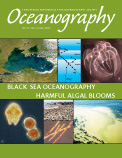First Paragraph
The Black Sea is the world’s largest marine anoxic basin. The Black Sea’s water below a depth of ~100 m is enriched with hydrogen sulfide that formed after the intrusion of seawater as a result of sea-level rise about 8,000 years ago (Deuser, 1974). Winter mixing in this sea results in the formation of an oxygen-rich cold intermediate layer (CIL), which is observed at depths of about 60 to 100 m. Transport of oxygen to the underlying water is connected with very weak processes of vertical turbulent exchange, which results in a very smooth decrease of redox potential. Therefore, the different oxidation-reduction reactions that occur there in narrow water layers form features that are characteristic hydrochemical structures (e.g., maxima and minima, and onset points). We call these features “chemotropic,” the connection between water density and the chemical structure’s properties (analogous to barotropic, the connection between density and pressure). The position of these chemotropic features in the density field is very stable (Vinogradov and Nalbandov, 1990; Turgul et al., 1992; Murray et al., 1995). The chemotropy of the Black Sea redox layer is well known, and this sea is successfully used as a natural laboratory to study processes that occur at the oxic/anoxic interface.

